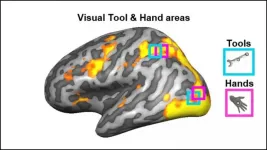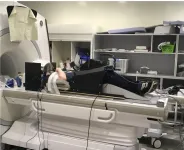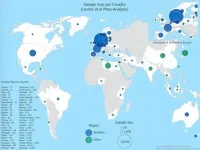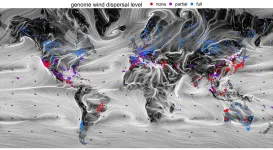(Press-News.org) MISSOULA - University of Montana Professor Mark Hebblewhite has joined an international team of 92 scientists and conservationists to create the first-ever global atlas of ungulate (hoofed mammal) migrations.
Working in partnership with the Convention on the Conservation of Migratory Species of Wild Animals, a U.N. treaty, the Global Initiative on Ungulate Migration (GIUM) launches May 7 with the publication of a commentary in Science titled " END
UM scientist joins team partnering with UN's initiative to map ungulate migrations
2021-05-10
ELSE PRESS RELEASES FROM THIS DATE:
Brain regions involved in vision also encode how to hold tools
2021-05-10
Visual brain areas involved in processing hands also encode information about the correct way to hold tools, according to new research published in JNeurosci.
Each part of the brain's visual system activates in response to a certain type of item -- whether it's faces, tools, objects, or hands. Scientists assumed the brain segregates visual information in this way to optimize motor actions with tools. Yet most studies investigating the brain mechanisms for tool grasping used images of tools or hands, and no actual hand movements were performed.
Knights et al. used fMRI to measure the brain activity of participants as they grasped 3D-printed kitchen tools (spoon, knife, and pizza cutter) and similar-sized non-tools. ...
UEA team reads minds to understand human tool use
2021-05-10
Researchers at the University of East Anglia have made an astonishing discovery about how our brains control our hands.
They used MRI data to study which parts of the brain are used when we handle tools, such as a knives.
They read out the signal from certain brain regions and tried to distinguish when participants handled tools appropriately for use.
Humans have used tools for millions of years, but this research is the first to show that actions such grasping a knife by its handle for cutting are represented by brain areas that also represent images of human hands, our primary 'tool' for interacting with the world.
The research ...
'Unmaking' a move: Correcting motion blur in single-photon images
2021-05-10
Imaging technology has come a long way since the beginning of photography in the mid-19th century. Now, many state-of-the-art cameras for demanding applications rely on mechanisms that are considerably different from those in consumer-oriented devices. One of these cameras employs what is known as "single-photon imaging," which can produce vastly superior results in dark conditions and fast dynamic scenes. But how does single-photon imaging differ from conventional imaging?
When taking a picture with a regular CMOS camera, like the ones on smartphones, ...
Monash study may help boost peptide design
2021-05-10
Peptides " short strings of amino acids" play a vital role in health and industry with a huge range of medical uses including in antibiotics, anti-inflammatory and anti-cancer drugs. They are also used in the cosmetics industry and for enhancing athletic performance. Altering the structure of natural peptides to produce improved compounds is therefore of great interest to scientists and industry. But how the machineries that produce these peptides work still isn't clearly understood.
Associate Professor Max Cryle from Monash University's Biomedicine Discovery Institute (BDI) has revealed a key aspect of peptide machinery in a paper published in Nature Communications today that provides a key to the "Holy Grail" of re-engineering peptides..
The findings will advance his lab's work into ...
Should we panic over declining sperm counts? Harvard researchers say not so fast
2021-05-10
A new study from the Harvard GenderSci Lab in the journal Human Fertility, "The Future of Sperm: A Biovariability Framework for Understanding Global Sperm Count Trends" questions the panic over apparent trends of declining human sperm count.
Recent studies have claimed that sperm counts among men globally, and especially from "Western" countries, are in decline, leading to apocalyptic claims about the possible extinction of the human species.
But the Harvard paper, by Marion Boulicault, Sarah S. Richardson, and colleagues, reanalyzes claims of precipitous human sperm declines, re-evaluating evidence presented in the widely-cited 2017 meta-analysis by Hagai Levine, Shanna ...
As global climate shifts, forests' futures may be caught in the wind
2021-05-10
Berkeley -- Forests' ability to survive and adapt to the disruptions wrought by climate change may depend, in part, on the eddies and swirls of global wind currents, suggests a new study by researchers at the University of California, Berkeley.
Unlike animals, the trees that make up our planet's forests can't uproot and find new terrain if conditions get tough. Instead, many trees produce seeds and pollen that are designed to be carried away by the wind, an adaptation that helps them colonize new territories and maximize how far they can spread their genes.
The ...
Differences between leopards are greater than between brown bears and polar bears
2021-05-10
New research demonstrates that African and Asian leopards are more genetically differentiated from one another than polar bears and brown bears. Indeed, leopards are so different that they ought to be treated as two separate species, according to a team of researchers, among them, scientists from the University of Copenhagen. This new knowledge has important implications for better conserving this big and beautiful, yet widely endangered cat.
No one has any doubts about polar bears and brown bears being distinct species. Leopards, on the other hand, are considered one and the same, a single species, whether of African or Asian ...
Intense light may hold answer to dilemma over heart treatment
2021-05-10
AURORA, Colo. (May 10, 2021) - Looking to safely block a gene linked to factors known to cause heart disease, scientists at the University of Colorado Anschutz Medical Campus may have found a new tool - light.
The study, published Monday in the journal Trends in Molecular Medicine, may solve a medical dilemma that has baffled scientists for years.
The gene, ANGPTL4, regulates fatty lipids in plasma. Scientists have found that people with lower levels of it also have reduced triglycerides and lipids, meaning less risk for cardiovascular disease.
But blocking the gene using antibodies triggered dangerous inflammation in mice. Complicating things further, the gene can also be beneficial in reducing the risk of myocardial ...
Bacteria do not colonize the gut before birth, says collaborative study
2021-05-10
Hamilton, ON (May 10, 2021) - It is well known that each person's gut bacteria is vital for digestion and overall health, but when does that gut microbiome start?
New research led by scientists from McMaster University and Charité - Universitätsmedizin Berlin in Germany has found it happens during and after birth, and not before.
McMaster researchers Deborah Sloboda and Katherine Kennedy examined prenatal stool (meconium) samples collected from 20 babies during breech Cesarean delivery.
"The key takeaway from our study is we are not colonized before birth. Rather, our relationship with our gut bacteria emerges ...
Growing sweet corn at higher densities doesn't increase root lodging risk
2021-05-10
URBANA, Ill. - Sweet corn growers and processors could be bringing in more profits by exploiting natural density tolerance traits in certain hybrids. That's according to 2019 research from USDA Agricultural Research Service (ARS) and University of Illinois scientists.
But since root systems get smaller as plant density goes up, some in the industry are concerned about the risk of root lodging with greater sweet corn density. New research says those concerns are unjustified.
"Root lodging can certainly be a problem for sweet corn, but not because of plant density. What really matters is the specific hybrid and the environment, those major rainfall and wind events that set up conditions for root structural failure," says ...






